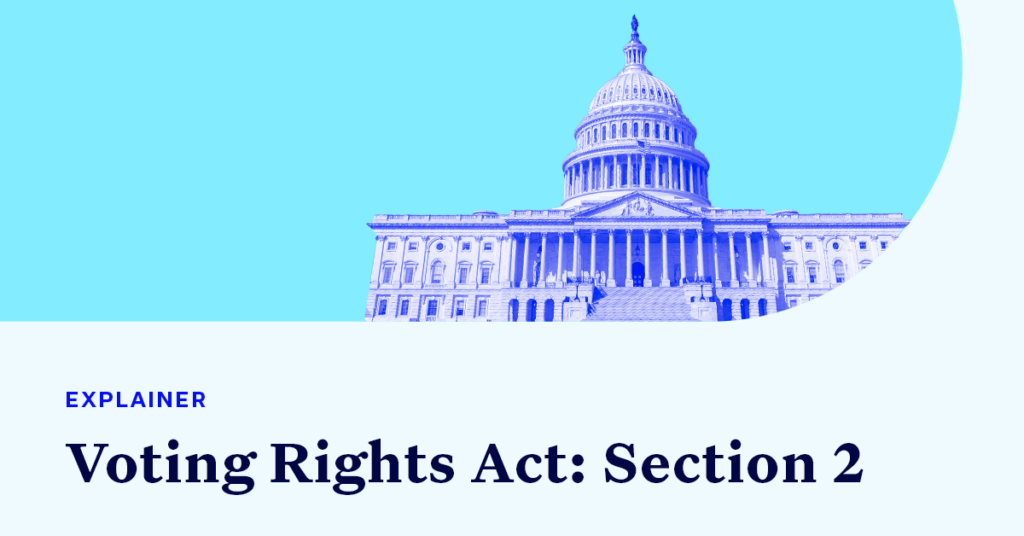Protecting Minority Voting Rights

Last week, we walked through how Section 5 of the historic Voting Rights Act of 1965 (VRA) was gutted in 2013, leaving a weakened VRA that opened the floodgates for the enactment of new voter suppression laws over the past eight years. However, the VRA still contains a significant weapon in the battle against minority voter suppression: Section 2.
The most litigated section of the VRA, Section 2 is the prohibition on any voting law that results in a “denial or abridgement of the right of any citizen of the United States to vote on account of race or color.” The U.S. Supreme Court initially interpreted Section 2 to protect only against election laws that were adopted with the intent to suppress minority voters. However, it can be difficult for disenfranchised voters to prove a law’s intent in court, and, in 1982, Congress amended Section 2 to make clear that an election law could also violate Section 2 if evidence showed the law has the result of “denying a racial or language minority an equal opportunity to participate in the political process.” Thanks to this amendment, Section 2 can be used to protect voters not only from voting laws that are motivated by discriminatory intent but also from those that have a discriminatory impact.
The Senate Committee on the Judiciary issued a report concurrent with the 1982 amendment that laid out several factors for courts to consider when deciding if an election law violates Section 2. This, paired with later court opinions, became known as the “results test,” which suggested several factors for courts to consider when determining the impact of an election law on minority communities. These factors include the history of voter discrimination in the state, the number of minority elected officials, racial polarization in elections and more. Using these factors to determine whether a law or practice violates Section 2 redefined voting rights litigation.
As the Supreme Court explained in Thornburg v. Gingles, “the essence of a Section 2 claim is that a certain electoral law, practice, or structure interacts with social and historical conditions to cause an inequality in the opportunities enjoyed by black and white voters to elect their preferred representatives.”
How has Section 2 been successfully used to strike down election laws that disenfranchise minority voters?
Voting rights activists have brought Section 2 claims against a variety of election laws including voter ID rules, registration restrictions, early vote requirements and redistricting legislation.
Some of the biggest voting rights court victories have been due in part to Section 2 claims. For example, in 2016, the 4th U.S. Circuit Court of Appeals found that the majority-Republican North Carolina General Assembly violated Section 2 when it enacted a slew of suppressive voting laws (including reducing or eliminating same-day registration, out-of-precinct voting, early voting and pre-registration) with the intent to discriminate against Black voters.
Section 2 has also been used in redistricting cases to prohibit vote dilution of minority groups when crafting electoral districts. Vote dilution can result from “cracking” a minority community into several election districts, such that they lack sufficient voting power in any one district to elect their candidates of choice, or “packing” members of a minority group into one district, weakening their voting power in surrounding districts and leaving them with less representation overall. The 1985 case Thornburg v. Gingles established the framework for challenging electoral districts under Section 2, after the Supreme Court found that North Carolina’s multi-member district plan violated the VRA because it suppressed Black voters’ ability to “participate equally in the political process and to elect candidates of their choice.”
To this day, disenfranchising election laws are being challenged in court under Section 2.
What is the future of Section 2 and its role in enforcing the VRA?
Much like other pro-voting measures, as American politics have become exponentially polarized so has support for Section 2. In 1982, it was the Reagan administration that expanded Section 2 when he signed the 25-year extension of the VRA and the results test amendment. But today, Republicans are attacking Section 2 in state legislatures and in the courts.
The most recent example was argued in front of the Supreme Court in early March: Brnovich v. Democratic National Committee. The case, which challenged two Arizona election laws as violations of Section 2, was appealed by the Arizona Republican Party and the Arizona Republican attorney general. The Republicans argued that “race-neutral regulations of the where, when, and how of voting do not implicate Section 2.” In other words, Republicans want to limit Section 2 by ending its ability to strike down laws that deal with the “ordinary” restrictions on the “time, place, or manner” of elections — even if the impacts of those laws make it harder for minority voters to cast their ballots.
In their argument before the Supreme Court, Republicans were transparent about why they are against Section 2. As the counsel for the Arizona GOP said in response to a question about the Arizona Republicans’ interest in keeping these disenfranchising laws, “it puts us at a competitive disadvantage relative to Democrats. Politics is a zero-sum game.”
That is why, no matter the Court’s decision in Brnovich, Congress must pass the John Lewis Voting Rights Advancement Act. The bill, among other VRA protections, would reinforce the results test of Section 2. We must take this vital step to enforce the most important civil rights act of the modern era and ensure that every eligible voter can enjoy an equal opportunity to participate in the electoral process.
Want to learn more about the specific sections of the VRA and how they are used in court to protect voting rights? Stay tuned for our next Voting Rights Act Explainer.